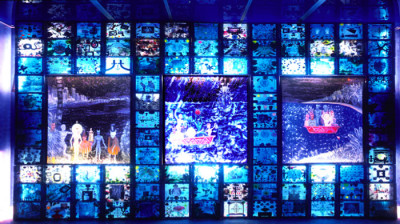NSU Newsroom
SharkBytes
Horizons
This version of NSU News has been archived as of February 28, 2019. To search through archived articles, visit nova.edu/search. To access the new version of NSU News, visit news.nova.edu.
This version of SharkBytes has been archived as of February 28, 2019. To search through archived articles, visit nova.edu/search. To access the new version of SharkBytes, visit sharkbytes.nova.edu.
The Indigo Room or Is Memory Water Soluble Art Exhibition, Currently on View at the MOA

The Indigo Room or Is Memory Water Soluble Edouard Duval-Carrie’
2004, Mixed media on Plexiglass and cast acrylic with assorted objects Courtesy of the artist and Bernice Steinbaum Galler.
This installation from the heart and hands of Edouard Duval-Carrié, with the assistance of students from the Dillard Center for the Arts, bespeaks the artist’s ineradicable connection to the island of his birth. Knowledgeable about Vodou since childhood, Duval-Carrié incorporates the religion’s theatrical sacred personages as players in his visual dramas of upheaval and transcendence. Migration out of Haiti, with consequences for the country left behind, is a persistent theme.
The twentieth-century renaissance in Haitian art has a proud exponent in Duval-Carrié, who portrays Vodou figures and rituals as Hector Hyppolite did in the 1940s and André Pierre does today. Yet he goes beyond their superficial depictions. Unlike fantasy-landscape artists and jungle-painters, who are fond of idealizing the mountainous island as a verdant paradise with unicorns, Duval-Carrié sees farther. He has an unblinking view of the Haiti he was born into, still grappling with the twin legacies of slavery and its history as a French colony. The artist pictures Haiti’s brutality along with its beauty.
A visual storyteller, Duval-Carrié has an unerring sense of color and texture in which he implants a treasure trove of things to discover. Despite the very specific Haitian imagery denoting both a tropical space and time, Duval-Carrié is an artist whose works have profound global resonance.